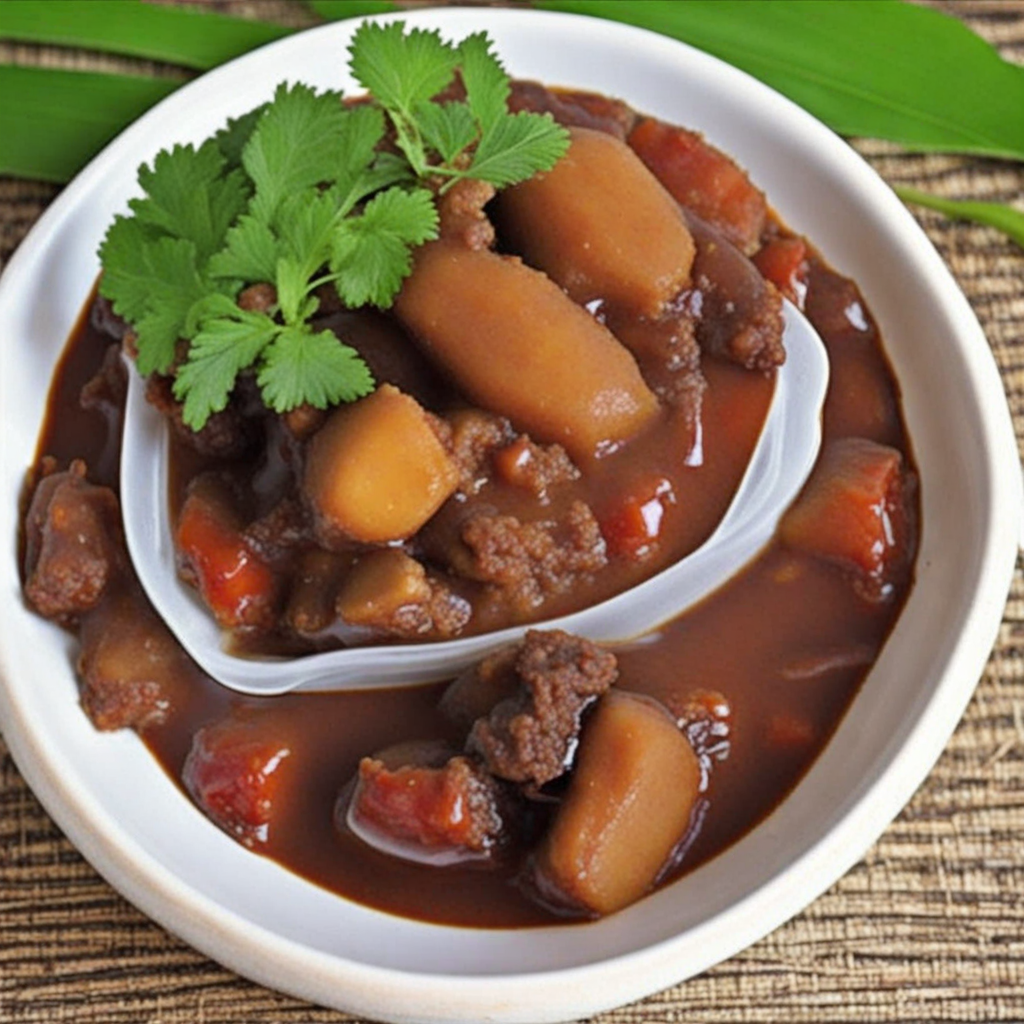Tamarind Stew
Tamarind stew is a beloved dish from Antigua and Barbuda that showcases the vibrant flavors and rich culinary heritage of the Caribbean. This stew is characterized by its unique use of tamarind, a tropical fruit that lends a distinctive tangy sweetness, making it a standout dish in the region's cuisine. Historically, tamarind has been utilized in various forms across cultures, but in Antigua and Barbuda, it has found a special place in traditional stews, reflecting the island's agricultural bounty and the influences of African, Caribbean, and European culinary traditions. The flavor profile of tamarind stew is a harmonious blend of sweet, sour, and savory notes. The base of the stew features the tartness of tamarind pulp, which is often tempered with the addition of savory ingredients such as onions, garlic, and peppers. This combination creates a balanced flavor that is both refreshing and comforting. The stew is typically enriched with a variety of spices, including thyme, allspice, and bay leaves, which contribute to its aromatic depth. The final result is a dish that is not only satisfying but also complex, inviting eaters to savor each spoonful. Preparation of tamarind stew usually begins with the tamarind pulp, which can be extracted from fresh pods or purchased as a paste. The pulp is often dissolved in water to create a tangy base for the stew. In a large pot, onions and garlic are sautéed until fragrant, followed by the addition of bell peppers and
How It Became This Dish
Tamarind stew, a beloved dish from Antigua and Barbuda, embodies the rich culinary heritage of the Caribbean. Its origins can be traced back to the indigenous peoples of the region, who utilized the tamarind fruit for its tangy flavor and medicinal properties. The tamarind tree, native to Africa but widely cultivated in tropical climates, was introduced to the Caribbean through trade routes as early as the 16th century. This exotic fruit quickly became an integral part of the local diet, prized for its versatility and distinctive flavor profile. The dish itself is a delicious medley of tamarind pulp, vegetables, and often a protein source such as chicken, beef, or seafood. The use of tamarind in cooking is particularly significant, as it reflects the fusion of various culinary traditions brought to the islands through colonization and the transatlantic slave trade. The incorporation of African, Spanish, and British influences has led to a unique culinary landscape in Antigua and Barbuda, where tamarind stew stands out as a testament to this rich cultural tapestry. Historically, tamarind stew served as a practical dish for local communities. The tamarind fruit was easily accessible and could be harvested from the wild, making it a staple ingredient. The stew was often prepared during communal gatherings or family celebrations, reinforcing social bonds among communities. It has become a symbol of hospitality, with many families passing down their unique recipes through generations, each adding their own twist to the dish. The communal aspect of preparing and sharing this stew strengthens ties within families and neighborhoods, highlighting its importance beyond mere sustenance. As the islands evolved, so did the preparation of tamarind stew. In the 20th century, with the rise of tourism in Antigua and Barbuda, the dish began to attract attention from visitors eager to experience authentic Caribbean flavors. Restaurants started to feature tamarind stew on their menus, often adapting the recipe to suit a variety of palates. Chefs would experiment with different proteins, such as shrimp or goat, and introduce spices and herbs that enhanced the dish's flavor, making it a popular choice for both locals and tourists alike. In recent years, there has been a renewed interest in traditional Caribbean dishes, including tamarind stew, as part of a broader movement to celebrate and preserve culinary heritage. Local chefs and home cooks alike have taken to social media platforms to share their recipes, showcasing the cultural significance of the dish. This revival has sparked a renewed appreciation for the intricate flavors and historical roots of tamarind stew, allowing younger generations to connect with their culinary heritage. The use of tamarind in the stew also highlights its nutritional benefits. Rich in vitamins and antioxidants, tamarind has been recognized for its potential health benefits, including aiding digestion and reducing inflammation. As health-conscious eating trends rise globally, the inclusion of tamarind in everyday cooking has prompted both locals and visitors to embrace this nutrient-rich ingredient, further solidifying its role in the Caribbean diet. Moreover, tamarind stew has become a focal point in culinary events and festivals in Antigua and Barbuda. Celebrations such as Antigua’s Carnival often feature local dishes, with tamarind stew being one of the highlights. This not only promotes local cuisine but also fosters a sense of pride among Antiguans and Barbudans, as they showcase their culinary traditions to the world. The dish serves as an ambassador of the islands' rich history and cultural diversity, encouraging dialogue about the importance of food as a cultural marker. As culinary tourism continues to grow, tamarind stew has found its way into the hearts and palates of many beyond the shores of Antigua and Barbuda. Food enthusiasts and chefs from around the globe have begun to experiment with tamarind in their cooking, inspired by the island's vibrant flavors. This cross-cultural exchange has led to a myriad of innovative dishes that incorporate tamarind, all paying homage to its origins in the Caribbean. Thus, tamarind stew not only serves as a traditional dish but also as a catalyst for culinary creativity and exploration. The journey of tamarind stew from indigenous staple to modern culinary delight illustrates the dynamic nature of food as a reflection of cultural identity. It encapsulates the story of Antigua and Barbuda—a narrative interwoven with the threads of history, migration, and communal bonds. In every bowl of tamarind stew, there lies a deep-seated appreciation for the land, its history, and the people who have shaped its culinary landscape over centuries. In conclusion, tamarind stew stands as a remarkable culinary tradition that has endured through time, celebrating the flavors of Antigua and Barbuda. Its evolution reflects broader societal changes while maintaining its core identity rooted in community and heritage. The dish continues to thrive, fostering connections among people and reminding us all of the power of food to tell stories and bridge cultures. Whether enjoyed at a family gathering or a bustling restaurant, tamarind stew remains a cherished embodiment of the rich culinary legacy of Antigua and Barbuda.
You may like
Discover local flavors from Antigua And Barbuda







